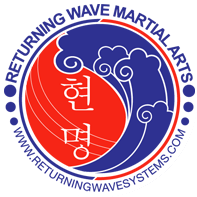by Richard Conceicao
Cat stance
A stance while not commonly used as much in modern-day karate still maintains its importance in self-defense situations. As with all stances described it must be understood that these are transitional states, they are not meant to be permanent postures that one takes as seen in our forms.
To begin with, stand with the feet parallel. For a left foot forward Stand, rotate the right foot out 45°. Move the left foot out so that the heel is in line with the right foots toes.
A. On the left foot (forward foot), only the area of the foot from the ball of the foot to the toes contacts the ground. This foot is either “empty” (unweighted), or only as a minimal amount of weight on it.
B. This stance is unique in that the spine has two different curvatures depending on whether or not the stance is an offensive or defensive one. In the offensive position the spine, as in the previous stances, is held straight with no curve in the back. In the defensive position however, the pelvis is tilted forward in order to move the groin backward, protecting it from a forward attack. This action actually increases the curvature of the lower back.
C. In all cases though, the legs from the thighs upward are squeezed together, thereby preventing excessive damage to either the groin, or the sensitive meridians running up the inner thigh.
TESTING STANCE STRUCTURE
While the above discussion is important for understanding the concepts necessary for proper structure of our stances it obviously cannot cover all the many variables of joint placement, height, body type, musculature, flexibility, etc. That is something that individuals have to determine for themselves. The way this is done is through testing.
Testing is done in a number of ways. There is static, bioelectric, and dynamic. For now, we will deal with our basic stances. However this discussion is relevant to blocks and strikes, and will be covered later.
A. Static
The individual stands in any given stance. His partner then presses on his hips, or pulls on his belt, in the directions that the stance has the most stability in. In other words, front to back for front stance, side to side for horseback stands, etc.
The object is to ensure that the individual can hold his stance integrity with a minimum of muscular effort, leaning, or shifting of position. Corrections to the stance should be made until it can be held with ease.
B. Bio electric (my thanks to Sensei Tony Annesi for demonstrating this)
While this is perhaps the most controversial methodology it does deserve consideration and trial. As before the individual assumes a particular stance and his partner attempts to stress it. However this time we place a third individual directly behind the testee.
That person extends his arm at the shoulder and the individual who is doing the stressing will attempt to press the arm down and assess the resistance afforded.
At the same time, the stressor will push the individual in his stance to attempt to disrupt the stance while he is pushing the arm down of the person behind him.
Very often, we will find that when the person has an incorrect or structurally unsound stance, the individual behind him finds his arm to be weaker and less able to resist the pressure downward. Conversely, when the stance is correct, often the individual is able to resist the pressure with ease
It has been conjectured that when an improper structure is stressed, the individual responds by drawing energy from all available sources surrounding them. Hence, the person behind them feels weaker.
While I am not attempting to prove this scientifically, I am suggesting that you try this methodology and see what your results are. There are many aspects of martial arts that, while they seem to border on the occult, are really just the way humans respond to different stimuli.
C. Dynamic
Once we are sure of our static structure, we now have to test it moving. Dynamic structure is the most difficult to maintain.
One method is to have our partner tie a belt to ours and behave as a weight for us to walk across the floor with. The trick is to ensure that all of our “checkpoints” remain correct.
We should exhibit no leaning forward of the torso; all power has to come from the legs and the hips. The correct position of the spine is critical—and easy to forget in our desire to use excessive force.
If everything is correct, you will notice that you are able to move with far less effort than you thought necessary. Try it with bad posture and see how much harder it becomes!
